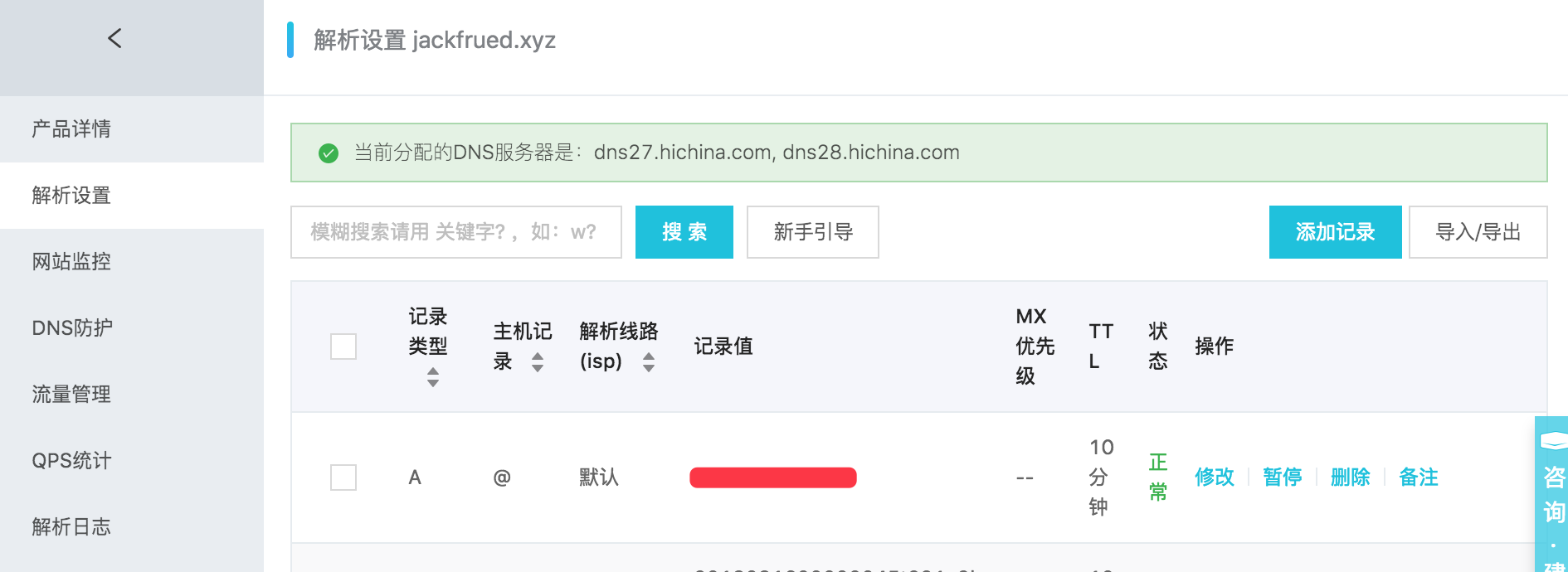27 KiB
项目部署上线指南
准备上线
-
上线前的检查工作。
python manage.py check --deploy -
将DEBUG设置为False并配置ALLOWED_HOSTS。
DEBUG = False ALLOWED_HOSTS = ['*'] -
安全相关的配置。
# 保持HTTPS连接的时间 SECURE_HSTS_SECONDS = 3600 SECURE_HSTS_INCLUDE_SUBDOMAINS = True SECURE_HSTS_PRELOAD = True # 自动重定向到安全连接 SECURE_SSL_REDIRECT = True # 避免浏览器自作聪明推断内容类型 SECURE_CONTENT_TYPE_NOSNIFF = True # 避免跨站脚本攻击 SECURE_BROWSER_XSS_FILTER = True # COOKIE只能通过HTTPS进行传输 SESSION_COOKIE_SECURE = True CSRF_COOKIE_SECURE = True # 防止点击劫持攻击手段 - 修改HTTP协议响应头 # 当前网站是不允许使用<iframe>标签进行加载的 X_FRAME_OPTIONS = 'DENY' -
敏感信息放到环境变量或文件中。
SECRET_KEY = os.environ['SECRET_KEY'] DB_USER = os.environ['DB_USER'] DB_PASS = os.environ['DB_PASS'] REDIS_AUTH = os.environ['REDIS_AUTH']
更新服务器Python环境到3.x
说明:如果需要清除之前的安装,就删除对应的文件和文件夹即可
-
安装底层依赖库。
yum -y install zlib-devel bzip2-devel openssl-devel ncurses-devel sqlite-devel readline-devel tk-devel gdbm-devel libdb4-devel libpcap-devel xz-devel libffi-devel -
下载Python源代码。
wget https://www.python.org/ftp/python/3.7.6/Python-3.7.6.tar.xz -
验证下载文件。
md5sum Python-3.7.6.tar.xz -
解压缩和解归档。
xz -d Python-3.7.6.tar.xz tar -xvf Python-3.7.6.tar -
执行安装前的配置(生成Makefile文件)。
cd Python-3.7.6 ./configure --prefix=/usr/local/python37 --enable-optimizations -
构建和安装。
make && make install -
配置PATH环境变量(用户或系统环境变量)并激活。
vim ~/.bash_profile vim /etc/profile... 此处省略上面的代码... export PATH=$PATH:/usr/local/python37/bin ... 此处省略下面的代码...source ~/.bash_profile source /etc/profile -
注册软链接(符号链接)- 这一步不是必须的,但通常会比较有用。
ln -s /usr/local/python37/bin/python3 /usr/bin/python3 -
测试Python环境是否更新成功(安装Python 3一定不能破坏原来的Python 2)。
python3 --version python --version
项目目录结构
假设项目文件夹为project,下面的五个子目录分别是:code、conf、logs、stat和venv分别用来保存项目的代码、配置文件、日志文件、静态资源和虚拟环境。其中,conf目录下的子目录cert中保存了配置HTTPS需要使用的证书和密钥;code目录下的项目代码可以通过版本控制工具从代码仓库中检出;虚拟环境可以通过工具(如:venv、virtualenv、pyenv等)进行创建。
project
├── code
│ └── fangtx
│ ├── api
│ ├── common
│ ├── fangtx
│ ├── forum
│ ├── rent
│ ├── user
│ ├── manage.py
│ ├── README.md
│ ├── static
│ └── templates
├── conf
│ ├── cert
│ │ ├── 214915882850706.key
│ │ └── 214915882850706.pem
│ ├── nginx.conf
│ └── uwsgi.ini
├── logs
│ ├── access.log
│ ├── error.log
│ └── uwsgi.log
├── stat
│ └── css
│ └── images
│ └── js
└── venv
├── bin
│ ├── activate
│ ├── activate.csh
│ ├── activate.fish
│ ├── celery
│ ├── celerybeat
│ ├── celeryd
│ ├── celeryd-multi
│ ├── coverage
│ ├── coverage3
│ ├── coverage-3.7
│ ├── django-admin
│ ├── django-admin.py
│ ├── easy_install
│ ├── easy_install-3.7
│ ├── pip
│ ├── pip3
│ ├── pip3.7
│ ├── __pycache__
│ ├── pyrsa-decrypt
│ ├── pyrsa-decrypt-bigfile
│ ├── pyrsa-encrypt
│ ├── pyrsa-encrypt-bigfile
│ ├── pyrsa-keygen
│ ├── pyrsa-priv2pub
│ ├── pyrsa-sign
│ ├── pyrsa-verify
│ ├── python -> python3
│ ├── python3 -> /usr/bin/python3
│ └── uwsgi
├── include
├── lib
│ └── python3.7
├── lib64 -> lib
├── pip-selfcheck.json
└── pyvenv.cfg
下面以阿里云为例,简单说明如何为项目注册域名、解析域名以及购买权威机构颁发的证书。
可以使用类似于sftp的工具将证书上传到conf/cert目录,然后使用git克隆项目代码到code目录。
cd code
git clone <url>
回到项目目录,创建并激活虚拟环境。
python3 -m venv venv
source venv/bin/activate
重建项目依赖项。
pip install -r code/teamproject/requirements.txt
uWSGI的配置
-
安装uWSGI。
pip install uwsgi -
修改uWSGI的配置文件(
/root/project/conf/uwsgi.ini)。[uwsgi] # 配置前导路径 base=/root/project # 配置项目名称 name=teamproject # 守护进程 master=true # 进程个数 processes=4 # 虚拟环境 pythonhome=%(base)/venv # 项目地址 chdir=%(base)/code/%(name) # 指定python解释器 pythonpath=%(pythonhome)/bin/python # 指定uwsgi文件 module=%(name).wsgi # 通信的地址和端口(自己服务器的IP地址和端口) socket=172.18.61.250:8000 # 日志文件地址 logto=%(base)/logs/uwsgi.log说明:可以先将“通信的地址和端口”项等号前面改为http来进行测试,如果没有问题再改回 成socket,然后通过Nginx来实现项目的“动静分离”(静态资源交给Nginx处理,动态内容交给 uWSGI处理)。按照下面的方式可以启动uWSGI服务器。
-
启动服务器。
nohup uwsgi --ini conf/uwsgi.ini &
Nginx的配置
-
安装Nginx。
yum -y install nginx -
修改全局配置文件(
/etc/nginx/nginx.conf)。# 配置用户 user nginx; # 工作进程数(建议跟CPU的核数量一致) worker_processes auto; # 错误日志 error_log /var/log/nginx/error.log; # 进程文件 pid /run/nginx.pid; # 包含其他的配置 include /usr/share/nginx/modules/*.conf; # 工作模式(多路IO复用方式)和连接上限 events { use epoll; worker_connections 1024; } # HTTP服务器相关配置 http { # 日志格式 log_format main '$remote_addr - $remote_user [$time_local] "$request" ' '$status $body_bytes_sent "$http_referer" ' '"$http_user_agent" "$http_x_forwarded_for"'; # 访问日志 access_log /var/log/nginx/access.log main; # 开启高效文件传输模式 sendfile on; # 用sendfile传输文件时有利于改善性能 tcp_nopush on; # 禁用Nagle来解决交互性问题 tcp_nodelay on; # 客户端保持连接时间 keepalive_timeout 30; types_hash_max_size 2048; # 包含MIME类型的配置 include /etc/nginx/mime.types; # 默认使用二进制流格式 default_type application/octet-stream; # 包含其他配置文件 include /etc/nginx/conf.d/*.conf; # 包含项目的Nginx配置文件 include /root/project/conf/*.conf; } -
编辑局部配置文件(
/root/project/conf/nginx.conf)。server { listen 80; server_name _; access_log /root/project/logs/access.log; error_log /root/project/logs/error.log; location / { include uwsgi_params; uwsgi_pass 172.18.61.250:8000; } location /static/ { alias /root/project/stat/; expires 30d; } } server { listen 443; server_name _; ssl on; access_log /root/project/logs/access.log; error_log /root/project/logs/error.log; ssl_certificate /root/project/conf/cert/214915882850706.pem; ssl_certificate_key /root/project/conf/cert/214915882850706.key; ssl_session_timeout 5m; ssl_ciphers ECDHE-RSA-AES128-GCM-SHA256:ECDHE:ECDH:AES:HIGH:!NULL:!aNULL:!MD5:!ADH:!RC4; ssl_protocols TLSv1 TLSv1.1 TLSv1.2; ssl_prefer_server_ciphers on; location / { include uwsgi_params; uwsgi_pass 172.18.61.250:8000; } location /static/ { alias /root/project/static/; expires 30d; } }到此为止,我们可以启动Nginx来访问我们的应用程序,HTTP和HTTPS都是没有问题的,如果Nginx已经运行,在修改配置文件后,我们可以用下面的命令重新启动Nginx。
-
重启Nginx服务器。
nginx -s reload或
systemctl restart nginx
说明:可以对Django项目使用
python manage.py collectstatic命令将静态资源收集到指定目录下,要做到这点只需要在项目的配置文件settings.py中添加STATIC_ROOT配置即可。
负载均衡配置
下面的配置中我们使用Nginx实现负载均衡,为另外的三个Nginx服务器(通过Docker创建)提供反向代理服务。
docker run -d -p 801:80 --name nginx1 nginx:latest
docker run -d -p 802:80 --name nginx2 nginx:latest
docker run -d -p 803:80 --name nginx3 nginx:latest
user root;
worker_processes auto;
error_log /var/log/nginx/error.log;
pid /run/nginx.pid;
include /usr/share/nginx/modules/*.conf;
events {
worker_connections 1024;
}
# 为HTTP服务配置负载均衡
http {
upstream xx {
server 192.168.1.100 weight=2;
server 192.168.1.101 weight=1;
server 192.168.1.102 weight=1;
}
server {
listen 80 default_server;
listen [::]:80 default_server;
listen 443 ssl;
listen [::]:443 ssl;
ssl on;
access_log /root/project/logs/access.log;
error_log /root/project/logs/error.log;
ssl_certificate /root/project/conf/cert/214915882850706.pem;
ssl_certificate_key /root/project/conf/cert/214915882850706.key;
ssl_session_timeout 5m;
ssl_ciphers ECDHE-RSA-AES128-GCM-SHA256:ECDHE:ECDH:AES:HIGH:!NULL:!aNULL:!MD5:!ADH:!RC4;
ssl_protocols TLSv1 TLSv1.1 TLSv1.2;
ssl_prefer_server_ciphers on;
location / {
proxy_set_header Host $host;
proxy_set_header X-Forwarded-For $remote_addr;
# proxy_set_header X-Real-IP $remote_addr;
# proxy_set_header X-Forwarded-For $proxy_add_x_forwarded_for;
proxy_buffering off;
proxy_pass http://fangtx;
}
}
}
说明:Nginx在配置负载均衡时,默认使用WRR(加权轮询算法),除此之外还支持ip_hash、fair(需要安装upstream_fair模块)和url_hash算法。此外,在配置upstream模块时可以指定服务器的状态值,包括:backup(备份机器,其他服务器不可用时才将请求分配到该机器)、down、fail_timeout(请求失败达到max_fails后的暂停服务时间)、max_fails(允许请求失败的次数)和weight(轮询的权重)。
Keepalived
当使用Nginx进行负载均衡配置时,要考虑负载均衡服务器宕机的情况。为此可以使用Keepalived来实现负载均衡主机和备机的热切换,从而保证系统的高可用性。Keepalived的配置还是比较复杂,通常由专门做运维的人进行配置,一个基本的配置可以参照《Keepalived的配置和使用》。
MySQL主从复制
下面还是基于Docker来演示如何配置MySQL主从复制。我们事先准备好MySQL的配置文件以及保存MySQL数据和运行日志的目录,然后通过Docker的数据卷映射来指定容器的配置、数据和日志文件的位置。
root
└── mysql
├── master
│ ├── conf
| └── data
└── slave-1
| ├── conf
| └── data
└── slave-2
| ├── conf
| └── data
└── slave-3
├── conf
└── data
-
MySQL的配置文件(master和slave的配置文件需要不同的server-id)。
[mysqld] pid-file=/var/run/mysqld/mysqld.pid socket=/var/run/mysqld/mysqld.sock datadir=/var/lib/mysql log-error=/var/log/mysql/error.log server-id=1 log-bin=/var/log/mysql/mysql-bin.log expire_logs_days=30 max_binlog_size=256M symbolic-links=0 # slow_query_log=ON # slow_query_log_file=/var/log/mysql/slow.log # long_query_time=1 -
创建和配置master。
docker run -d -p 3306:3306 --name mysql-master \ -v /root/mysql/master/conf:/etc/mysql/mysql.conf.d \ -v /root/mysql/master/data:/var/lib/mysql \ -e MYSQL_ROOT_PASSWORD=123456 mysql:5.7 docker exec -it mysql-master /bin/bashmysql -u root -p Enter password: Welcome to the MySQL monitor. Commands end with ; or \g. Your MySQL connection id is 1 Server version: 5.7.23-log MySQL Community Server (GPL) Copyright (c) 2000, 2018, Oracle and/or its affiliates. All rights reserved. Oracle is a registered trademark of Oracle Corporation and/or its affiliates. Other names may be trademarks of their respective owners. Type 'help;' or '\h' for help. Type '\c' to clear the current input statement. mysql> grant replication slave on *.* to 'slave'@'%' identified by 'iamslave'; Query OK, 0 rows affected, 1 warning (0.00 sec) mysql> flush privileges; Query OK, 0 rows affected (0.00 sec) mysql> show master status; +------------------+----------+--------------+------------------+-------------------+ | File | Position | Binlog_Do_DB | Binlog_Ignore_DB | Executed_Gtid_Set | +------------------+----------+--------------+------------------+-------------------+ | mysql-bin.000003 | 590 | | | | +------------------+----------+--------------+------------------+-------------------+ 1 row in set (0.00 sec) mysql> quit Bye exit上面创建Docker容器时使用的
-v参数(--volume)表示映射数据卷,冒号前是宿主机的目录,冒号后是容器中的目录,这样相当于将宿主机中的目录挂载到了容器中。 -
备份主表中的数据(如果需要的话)。
mysql> flush table with read lock;mysqldump -u root -p 123456 -A -B > /root/backup/mysql/mybak$(date +"%Y%m%d%H%M%S").sqlmysql> unlock table; -
创建和配置slave。
docker run -d -p 3308:3306 --name mysql-slave-1 \ -v /root/mysql/slave-1/conf:/etc/mysql/mysql.conf.d \ -v /root/mysql/slave-1/data:/var/lib/mysql \ -e MYSQL_ROOT_PASSWORD=123456 \ --link mysql-master:mysql-master mysql:5.7 docker run -d -p 3309:3306 --name mysql-slave-2 \ -v /root/mysql/slave-2/conf:/etc/mysql/mysql.conf.d \ -v /root/mysql/slave-2/data:/var/lib/mysql \ -e MYSQL_ROOT_PASSWORD=123456 \ --link mysql-master:mysql-master mysql:5.7 docker run -d -p 3310:3306 --name mysql-slave-3 \ -v /root/mysql/slave-3/conf:/etc/mysql/mysql.conf.d \ -v /root/mysql/slave-3/data:/var/lib/mysql \ -e MYSQL_ROOT_PASSWORD=123456 \ --link mysql-master:mysql-master mysql:5.7 docker exec -it mysql-slave-1 /bin/bashmysql -u root -p Enter password: Welcome to the MySQL monitor. Commands end with ; or \g. Your MySQL connection id is 2 Server version: 5.7.23-log MySQL Community Server (GPL) Copyright (c) 2000, 2018, Oracle and/or its affiliates. All rights reserved. Oracle is a registered trademark of Oracle Corporation and/or its affiliates. Other names may be trademarks of their respective owners. Type 'help;' or '\h' for help. Type '\c' to clear the current input statement. mysql> reset slave; Query OK, 0 rows affected (0.02 sec) mysql> change master to master_host='mysql-master', master_user='slave', master_password='iamslave', master_log_file='mysql-bin.000003', master_log_pos=590; Query OK, 0 rows affected, 2 warnings (0.03 sec) mysql> start slave; Query OK, 0 rows affected (0.01 sec) mysql> show slave status\G *************************** 1. row *************************** Slave_IO_State: Waiting for master to send event Master_Host: mysql57 Master_User: slave Master_Port: 3306 Connect_Retry: 60 Master_Log_File: mysql-bin.000001 Read_Master_Log_Pos: 590 Relay_Log_File: f352f05eb9d0-relay-bin.000002 Relay_Log_Pos: 320 Relay_Master_Log_File: mysql-bin.000001 Slave_IO_Running: Yes Slave_SQL_Running: Yes Replicate_Do_DB: Replicate_Ignore_DB: Replicate_Do_Table: Replicate_Ignore_Table: Replicate_Wild_Do_Table: Replicate_Wild_Ignore_Table: Last_Errno: 0 Last_Error: Skip_Counter: 0 Exec_Master_Log_Pos: 590 Relay_Log_Space: 534 Until_Condition: None Until_Log_File: Until_Log_Pos: 0 Master_SSL_Allowed: No Master_SSL_CA_File: Master_SSL_CA_Path: Master_SSL_Cert: Master_SSL_Cipher: Master_SSL_Key: Seconds_Behind_Master: 0 Master_SSL_Verify_Server_Cert: No Last_IO_Errno: 0 Last_IO_Error: Last_SQL_Errno: 0 Last_SQL_Error: Replicate_Ignore_Server_Ids: Master_Server_Id: 1 Master_UUID: 30c38043-ada1-11e8-8fa1-0242ac110002 Master_Info_File: /var/lib/mysql/master.info SQL_Delay: 0 SQL_Remaining_Delay: NULL Slave_SQL_Running_State: Slave has read all relay log; waiting for more updates Master_Retry_Count: 86400 Master_Bind: Last_IO_Error_Timestamp: Last_SQL_Error_Timestamp: Master_SSL_Crl: Master_SSL_Crlpath: Retrieved_Gtid_Set: Executed_Gtid_Set: Auto_Position: 0 Replicate_Rewrite_DB: Channel_Name: Master_TLS_Version: 1 row in set (0.00 sec) mysql> quit Bye exit接下来可以如法炮制配置出slave2和slave3,这样就可以搭建起一个“一主带三从”的主从复制环境。上面创建创建容器时使用的
--link参数用来配置容器在网络上的主机名(网络地址别名)。
配置好主从复制后,写数据的操作应该master上执行,而读数据的操作应该在slave上完成。为此,在Django项目中需要配置DATABASE_ROUTERS并通过自定义的主从复制路由类来实现读写分离操作,如下所示:
DATABASE_ROUTERS = [
# 此处省略其他配置
'common.routers.MasterSlaveRouter',
]
class MasterSlaveRouter(object):
"""主从复制路由"""
@staticmethod
def db_for_read(model, **hints):
"""
Attempts to read auth models go to auth_db.
"""
return random.choice(('slave1', 'slave2', 'slave3'))
@staticmethod
def db_for_write(model, **hints):
"""
Attempts to write auth models go to auth_db.
"""
return 'default'
@staticmethod
def allow_relation(obj1, obj2, **hints):
"""
Allow relations if a model in the auth app is involved.
"""
return None
@staticmethod
def allow_migrate(db, app_label, model_name=None, **hints):
"""
Make sure the auth app only appears in the 'auth_db'
database.
"""
return True
上面的内容参考了Django官方文档的DATABASE_ROUTERS配置,对代码进行了适当的调整。
Docker
事实上,项目上线中最为麻烦的事情就是配置软件运行环境,环境的差异会给软件的安装和部署带来诸多的麻烦,而Docker正好可以解决这个问题。关于Docker在之前的文档中我们已经介绍过了,接下来我们对Docker的知识做一些必要的补充。
-
创建镜像文件。
将容器保存成镜像:
docker commit -m "..." -a "jackfrued" <container-name> jackfrued/<image-name>使用Dockerfile构建镜像:
# 指定基础镜像文件 FROM centos:latest # 指定维护者信息 MAINTAINER jackfrued # 执行命令 RUN yum -y install gcc RUN cd ~ RUN mkdir -p project/code RUN mkdir -p project/logs # 拷贝文件 COPY ... # 暴露端口 EXPOSE ... # 在容器启动时执行命令 CMD ~/init.shdocker build -t jackfrued/<image-name> . -
镜像的导入和导出。
docker save -o <file-name>.tar <image-name>:<version> docker load -i <file-name>.tar -
推送到DockerHub服务器。
docker tag <image-name>:<version> jackfrued/<name> docker login docker push jackfrued/<name> -
容器之间的通信。
docker run --link <container-name>:<alias-name>
如果我们能够在Docker中完成项目的部署,并且将整个部署好的容器打包成镜像文件进行分发和安装,这样就可以解决项目在多个节点上进行部署时可能遇到的麻烦,而且整个部署可以在很短的时间内完成。
Supervisor
Supervisor是一个用Python写的进程管理工具,可以很方便的用来在类Unix系统下启动、重启(自动重启程序)和关闭进程,目前Supervisor暂时还没有提供对Python 3的支持,可以通过Python 2来安装和运行Supervisor,再通过Supervisor来管理Python 3的程序。
提示:还有一个和Supervisor功能类似的工具名为Circus,支持Python 3。
-
安装Supervisor。
virtualenv -p /usr/bin/python venv source venv/bin/activate pip install supervisor -
查看Supervisor的配置文件。
vim /etc/supervisord.conf; 此处省略上面的代码 ; The [include] section can just contain the "files" setting. This ; setting can list multiple files (separated by whitespace or ; newlines). It can also contain wildcards. The filenames are ; interpreted as relative to this file. Included files *cannot* ; include files themselves. [include] files = supervisord.d/*.ini可以看出自定义的管理配置代码可以放在
/etc/supervisord.d目录中,并且文件名以ini作为后缀即可。 -
编写自己的配置文件
fangtx.ini并放在/etc/supervisord.d目录中。[program:project] command=uwsgi --ini /root/project/conf/uwsgi.ini stopsignal=QUIT autostart=true autorestart=true redirect_stderr=true [program:celery] ; Set full path to celery program if using virtualenv command=/root/project/venv/bin/celery -A fangtx worker user=root numprocs=1 stdout_logfile=/var/log/supervisor/celery.log stderr_logfile=/var/log/supervisor/celery_error.log autostart=true autorestart=true startsecs=10 ; Need to wait for currently executing tasks to finish at shutdown. ; Increase this if you have very long running tasks. ;stopwaitsecs = 600 ; When resorting to send SIGKILL to the program to terminate it ; send SIGKILL to its whole process group instead, ; taking care of its children as well. killasgroup=true ; Set Celery priority higher than default (999) ; so, if rabbitmq is supervised, it will start first. priority=1000 -
启动Supervisor。
supervisorctl -c /etc/supervisord.conf
其他服务
-
常用开源软件。
功能 开源方案 版本控制工具 Git、Mercurial、SVN 缺陷管理 Redmine、Mantis 负载均衡 Nginx、LVS、HAProxy 邮件服务 Postfix、Sendmail HTTP服务 Nginx、Apache 消息队列 RabbitMQ、ZeroMQ、Redis、Kafka 文件系统 FastDFS 基于位置服务(LBS) MongoDB、Redis 监控服务 Nagios、Zabbix 关系型数据库 MySQL、PostgreSQL 非关系型数据库 MongoDB、Redis、Cassandra、TiDB 搜索引擎 ElasticSearch、Solr 缓存服务 Mamcached、Redis -
常用云服务。
功能 可用的云服务 团队协作工具 Teambition、钉钉 代码托管平台 Github、Gitee、CODING 邮件服务 SendCloud 云存储(CDN) 七牛、OSS、LeanCloud、Bmob、又拍云、S3 移动端推送 极光、友盟、百度 即时通信 环信、融云 短信服务 云片、极光、Luosimao、又拍云 第三方登录 友盟、ShareSDK 网站监控和统计 阿里云监控、监控宝、百度云观测、小鸟云




